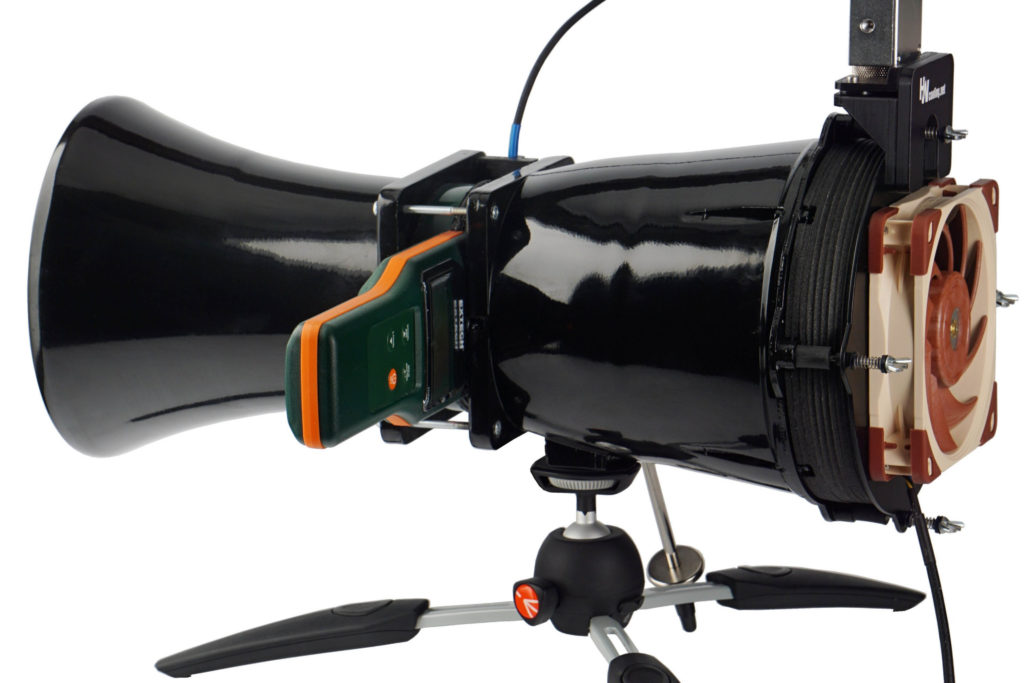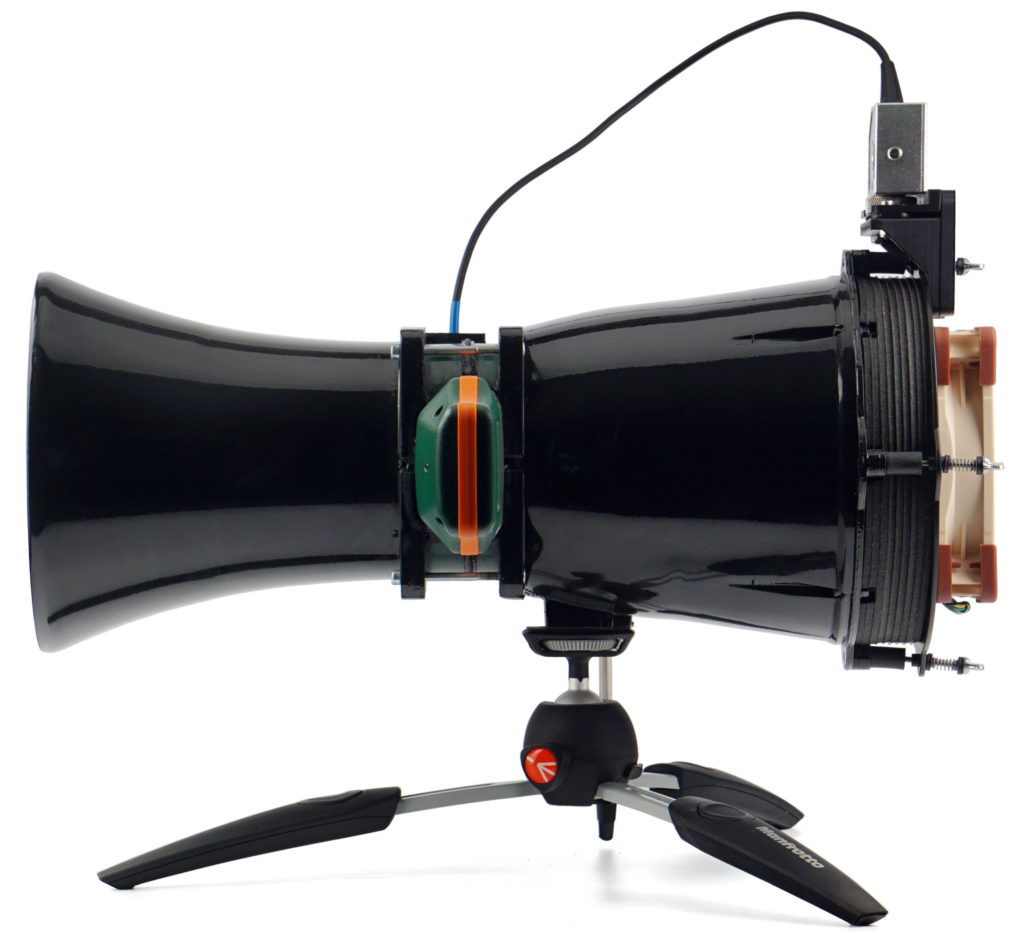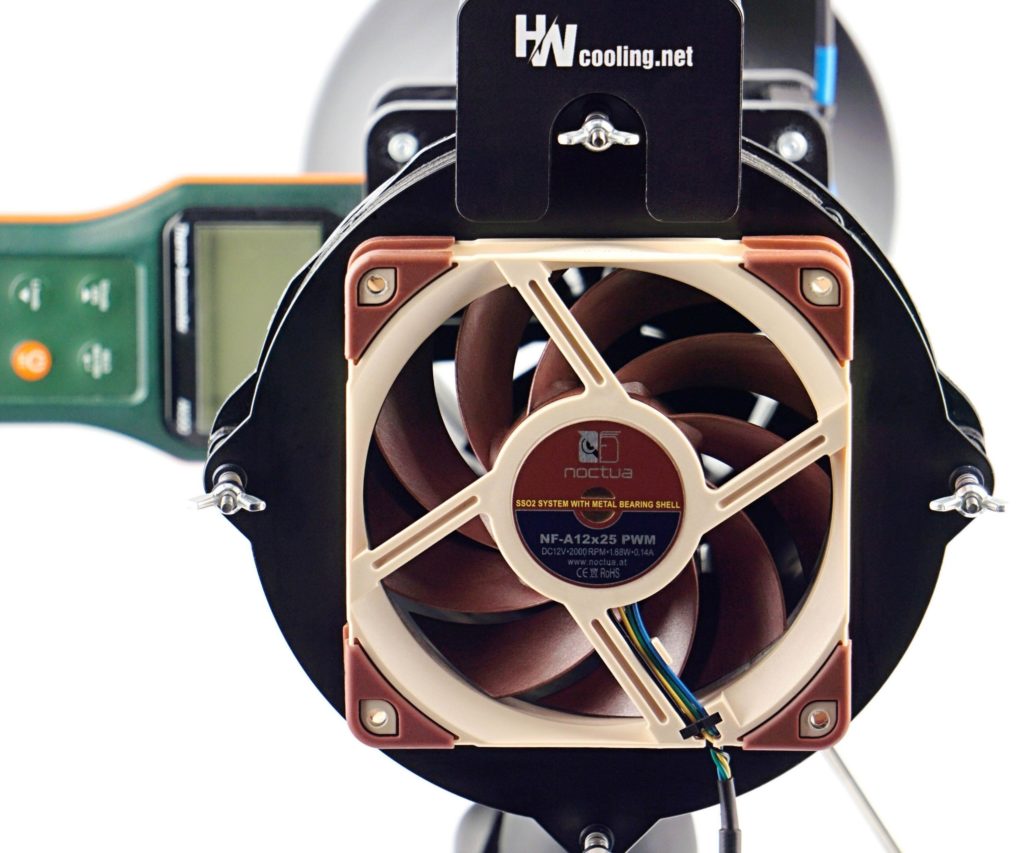Basis of the methodology, the wind tunnel
Longer life in exchange for more noise? These are also some of the agenda items we’ll cover in our comparison of the Arctic P14 CO fan with the fluid bearing variant. These are actually the main points. In any case, the ball bearings in the more expensive variant of these fans also have specific features that can be easily observed and distinguished even in normal, “home” use.
Basis of the methodology, the wind tunnel
Before you start reading the methodology with all the details, take a look at the test tunnel as a whole. This is the heart of the whole system, to which other arteries are connected (manometer, vibrometer, powermeter, …). The only solid part of the tunnel from the measuring instruments is the anemometer.
The shape of the wind tunnel is inspired by the Venturi tube, which has long been used to measure the flow of liquids and gasses. The Venturi effect for wind speed measuring is also known from the aerospace industry. However, the design for measuring computer fans has its own specificities, which this proposal of ours reflects.
The individual parameters of the HWC wind tunnel for fan tests are the result of physical simulations and practical debugging. All the details (folds, material or finish used) have a rationale behind them and are designed this way for a specific reason. We will discuss the individual design details in turn in the description of the sub-variable measurements.
Now we will briefly elaborate on some things that do not fit thematically into the text of the following chapters. Namely, for example, that the skeleton of the wind tunnel is the work of a 3D printer (PLA). The rough print was, of course, then thoroughly machined by grinding, fusing, polishing and varnishing. Especially important is the smooth finish of the interior walls.
When joining the individual parts, the emphasis was on making sure that they fit together flawlessly, that they were sealed flawlessly (we will come back to this when we describe the test procedures for pressure measurement), but also that the joints were not loosened by use. Everything is disassemblable for servicing purposes, but it is ensured that the properties are maintained during use and, for example, even under the stress of vibration. The threads are secured with either lock nuts or thread-locking fluid. It depends on which is more suitable in which place.
When the wind tunnel is not in use, it is enclosed in a dust-tight chamber. In addition to the technical equipment and its correct storage, it is also important for objective outputs that all measuring instruments are calibrated according to the standard. Without this, it would be impossible to stand behind your results and rely on the manufacturers’ specifications. Calibration protocols are therefore an important part of the methodology. Testing is carried out at an ambient air temperature of 21–21.3 °C, humidity is approximately 45 % (± 2 %).
Fans come to us for testing in at least two pieces of the same model. If the deviations of any of the measured values are greater than 5 %, we also work with a third or fourth sample and the average value is formed by the results of the fans that came out the most similar and the differences between them fit under 5 %.
- Contents
- Arctic P14 PWM PST CO in detail
- Overview of manufacturer specifications
- Basis of the methodology, the wind tunnel
- Mounting and vibration measurement
- Initial warm-up and speed recording
- Base 6 equal noise levels…
- ... and sound color (frequency characteristic)
- Measurement of static pressure…
- … and of airflow
- Everything changes with obstacles
- How we measure power draw and motor power
- Measuring the intensity (and power draw) of lighting
- Results: Speed
- Results: Airlow w/o obstacles
- Results: Airflow through a nylon filter
- Results: Airflow through a plastic filter
- Results: Airflow through a hexagonal grille
- Results: Airflow through a thinner radiator
- Results: Airflow through a thicker radiator
- Results: Static pressure w/o obstacles
- Results: Static pressure through a nylon filter
- Results: Static pressure through a plastic filter
- Results: Static pressure through a hexagonal grille
- Results: Static pressure through a thinner radiator
- Results: Static pressure through a thicker radiator
- Results: Static pressure, efficiency depending on orientation
- Reality vs. specifications
- Results: Frequency response of sound w/o obstacles
- Results: Frequency response of sound with a dust filter
- Results: Frequency response of sound with a hexagonal grille
- Results: Frequency response of sound with a radiator
- Results: Vibration, in total (3D vector length)
- Results: Vibration, X-axis
- Results: Vibration, Y-axis
- Results: Vibration, Z-axis
- Results: Power draw (and motor power)
- Results: Cooling performance per watt, airflow
- Results: Cooling performance per watt, static pressure
- Airflow per euro
- Static pressure per euro
- Results: Lighting – LED luminance and power draw
- Results: LED to motor power draw ratio
- Evaluation















Expected results, but still an interesting showcase of the effect of only changing the bearings.
So, the “hum” is still here all the same, despite some claims that the CO version fixes it. ThermalLeft has documented sound differences between revisions too (https://www.youtube.com/watch?v=nt8Ao4GDmzY), but even Arctic themselves doesn’t think revisions will have such an effect. I am starting to think it’s possibly a batch “issue” that may have introduced different properties to the rotor material.
I guess those claims of the CO rumbling less will never come from an official source (from Arctic)? They don’t seem to list among the changes across the revisions the modifications that address this. And personally, I don’t even see the technical reason behind the CO variant or the higher P14 revision (2 vs. 4) being quieter on lower frequencies. The impeller seems to have the same parameters in terms of geometry or material used. Nevertheless, there can certainly be a situation where different noise levels are measured across different fans. But it may not be due to different revisions, and perhaps it may be possible to observe this across different fan pieces of the same revision due to different manufacturing tolerances (which are high in the low-end after all)?
An analysis that tracks the tonal peaks of multiple pieces from the same revisions on each side would shed more light on this. From our experience, we note that the shape of the spectrograms of multiple pieces of the P14 PWM PST rev. 4 compared to P14 PWM PST CO rev. 3 in the low frequency band is identical at the same speed. The small differences in the spectrograms that you see in the tests are mainly just due to the fact that in modes normalized by the same noise levels, the speeds of the two variants (P14 and P14 CO fans) are slightly different. For the CO, the speeds are always set a little lower due to the noisier bearings.
Perhaps what is known as “resonance” is something else that’s not the frequency spike at ~100 Hz. Namely, the sudden increase in noise at specific RPM ranges. Or, perhaps the two issues are lumped together when people talk about it, when in fact the two (sound profile with pronounced low frequency peak, and some RPM ranges being suddenly louder) are different issues (that perhaps are related).
I am sure you would have noticed and mentioned it though, when you’re testing the fans and adjusting the fan speeds again and again.